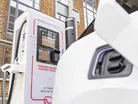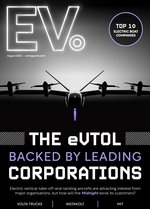A rapid charge towards public electrification potential

No more negative press about EVs. Positivity around the subject is what drives the initiative forward, and with more companies and consumers on board with electrification, the faster the rate of innovation.
Few dispute the need to reassess our transport options, yet some remain to be convinced. Perhaps the only way to win over the naysayers is to give them what they want: faster charging options.
We can’t shake the fact that rapid EV charging is vital at this pivotal moment in automotive evolution, but is it truly necessary? And if so, when will it be commonplace? Adrian Keen (AK) CEO of InstaVolt shares his thoughts on this as the company drives innovation to reduce charge times.
TS: What is hindering further rollout of rapid charging?
AK: While private companies are hitting targets and making pledges to create a charging infrastructure that supports a full consumer transition, there is a lack of media and consumer confidence in the EV charging industry, which creates a barrier in the switch to electric.
Negative media coverage is leading consumers to believe that there is an unfixable disparity between the number of EVs on the road and corresponding charging infrastructure, and while we respect the figures from the SMMT, the reality for EV drivers on the road is different.
Despite reports of queues for EV chargers on recent bank holiday weekends, the UK EV infrastructure providers should be being applauded. We are investing in our infrastructure, and more chargers are being installed than ever before. The pipeline is still strong enough to deliver the required numbers by 2030, with InstaVolt individually installing record numbers of chargers in the first quarter of 2023.
Stable infrastructure is just one part of the full EV transition. We must take the opportunity to encourage and applaud progress to give existing and future drivers confidence that there are rapid chargers available.
TS: Is there a viable alternative to rapid charging?
AK: Rapid public charging gives consumers convenience and an opportunity to rest and recharge their own batteries for 30 minutes to an hour while their EV is being charged. Drivers and their passengers can shop, grab a hot drink or a meal at nearby amenities or simply relax – something our busy world has grown accustomed to avoiding.
Most of our chargers are situated in locations with multiple food and drink amenities,to give consumers options while charging.
When it comes to convenience, location is vital for the rapid-charge network in the UK. Where EV owners don’t have a private charger at their disposal, the public charging network gives EV drivers the confidence to travel, given the number of chargers available up and down the country.
For those who have a private driveway, home chargers are of course brilliantly convenient, allowing EV owners to charge overnight. But we know that that’s not the reality for a significant portion of the UK. This is why continuing to install as many conveniently placed and efficient options as possible remains our end goal.
TS: How can we best reduce range anxiety?
AK: Range anxiety will soon be a thing of the past. Industry findings suggest that reports on charging anxiety don't match the reality. This is evidenced by The AA’s recent report of a 70% drop in call outs for ‘out of charge’ EVs. We already offer charge confidence to our drivers.
There is an array of tools allowing easy location of local chargers, such as ZapMap or InstaVolt’s own app, and these allow drivers to plan their route accordingly.
While it requires a little more planning ahead of travel, such solutions are important for reducing range anxiety.
Businesses can help here by partnering with trusted charge-point networks, to ensure drivers have access to reliable chargers.
Choosing the InstaVolt network gives fleet drivers access to rapid, reliable charging at nationwide locations, and multi-charger sites helps minimise driver downtime.
TS: What does an adequate charging network look like?
AK: It’s essential it keeps up with the demand of EV adoption. However, this isn’t solely focused on charger numbers, but also network reliability and driver experience.
We’re focused on ensuring our network availability remains at an industry leading 99.9%, which is key to the customer experience. We monitor the health of our network in real time so our team of service engineers can react to any issue or fault as soon as it arises.
Vital to mass EV adoption is ensuring there are enough chargers available. We have plans to install 10,000 rapid chargers by 2030, and with 1,200 existing chargers across the country, InstaVolt is installing at a faster rate than any other charge point operator. We are committed to our rapid roll-out, to reach these goals and pave the way to an electric future.
Finally, we’re focusing on driver experience. We see the market demanding more hubs – sites of eight or more chargers, with food and drink amenities for drivers, good access and sufficient power. We’re building a truly nationwide network that provides an enjoyable charging experience for all drivers.
- Hyundai Mobis Unveils New EV Battery Cooling TechnologyCharging & Infrastructure
- Aquarius Engines' EV Charging Pilot with EnviroChargeCharging & Infrastructure
- bp pulse and DPD Partner to Upgrade UK EV ChargingCharging & Infrastructure
- Stagecoach Partners with Schneider Electric for EV ChargingSustainability


